The Cerebral Palsy Market is estimated to be valued at USD 3.1 billion in 2025 and is projected to reach USD 4.1 billion by 2035, registering a compound annual growth rate (CAGR) of 2.9% over the forecast period.
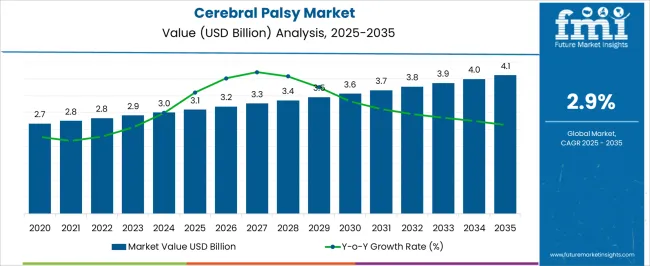
| Metric | Value |
|---|---|
| Cerebral Palsy Market Estimated Value in (2025 E) | USD 3.1 billion |
| Cerebral Palsy Market Forecast Value in (2035 F) | USD 4.1 billion |
| Forecast CAGR (2025 to 2035) | 2.9% |
The Cerebral Palsy market is experiencing consistent growth, driven by increasing prevalence of neurological disorders and the rising need for effective therapeutic interventions. Growing awareness about early diagnosis, rehabilitation, and long-term management of cerebral palsy is contributing to market expansion across pediatric and adult populations. The development and adoption of pharmacological therapies, assistive devices, and rehabilitative care strategies are enhancing patient outcomes while improving quality of life.
Rising investment in healthcare infrastructure, research funding, and clinical trials is further supporting innovation in treatments. The integration of multidisciplinary care approaches and personalized therapy plans is enabling targeted interventions for patients with varying degrees of severity. Regulatory frameworks and guidelines promoting access to essential medications and therapeutic services are also influencing market adoption.
As healthcare systems in developed and emerging regions continue to focus on early intervention, specialized care, and long-term patient management, the market is expected to maintain steady growth Technological advancements, combined with increasing awareness among caregivers and healthcare providers, are anticipated to further strengthen market momentum over the coming decade.
The cerebral palsy market is segmented by drug type, type of cerebral palsy, distribution channel, and geographic regions. By drug type, cerebral palsy market is divided into Anticonvulsants Drugs, Anticholinergic Drugs, Antidepressants Drugs, Anti-Spastic Drugs, Anti-Inflammatory Drugs, and Others. In terms of type of cerebral palsy, cerebral palsy market is classified into Spastic Cerebral Palsy, Dyskinetic Cerebral Palsy, Hypotonic Cerebral Palsy, Ataxic Cerebral Palsy, and Mixed Cerebral Palsy. Based on distribution channel, cerebral palsy market is segmented into Hospitals, Retails Pharmacies, and Online Pharmacies. Regionally, the cerebral palsy industry is classified into North America, Latin America, Western Europe, Eastern Europe, Balkan & Baltic Countries, Russia & Belarus, Central Asia, East Asia, South Asia & Pacific, and the Middle East & Africa.
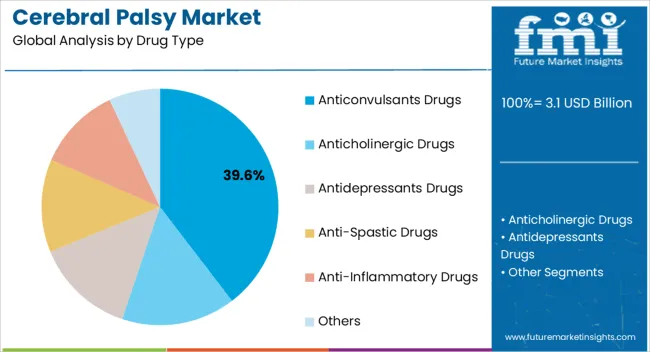
The anticonvulsants drugs segment is projected to hold 39.6% of the market revenue in 2025, establishing it as the leading drug type. This segment’s growth is being driven by the prevalence of seizure-related complications in cerebral palsy patients, which necessitates consistent pharmacological management. Anticonvulsants are being increasingly preferred for their efficacy in controlling seizures and improving overall neurological stability.
Advances in formulation development, dosage optimization, and safety profiles have enhanced adoption among clinicians and patients. The ability to combine anticonvulsants with other therapeutic interventions, including physiotherapy and rehabilitative care, provides comprehensive management of cerebral palsy symptoms.
Increased accessibility through healthcare facilities and pharmacies, along with growing clinical awareness, has reinforced market dominance As research continues to explore more effective and targeted anticonvulsant therapies, this segment is expected to maintain its leading position, supported by widespread clinical use, regulatory approvals, and the ongoing emphasis on managing neurological complications in cerebral palsy patients.
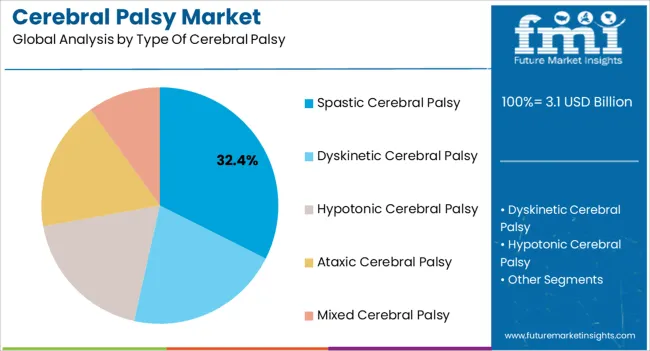
The spastic cerebral palsy segment is anticipated to account for 32.4% of the market revenue in 2025, making it the leading type of cerebral palsy. Its prominence is being driven by the high prevalence of spasticity, which affects motor function and mobility in the majority of cerebral palsy cases. Pharmacological therapies, including muscle relaxants and anticonvulsants, alongside physiotherapy interventions, are being used to manage symptoms effectively.
Advances in early detection and targeted interventions have enhanced patient outcomes, further supporting adoption. The ability to implement multidisciplinary care approaches, combining medical treatment with physical and occupational therapies, has strengthened the clinical management of spastic cerebral palsy.
Growing awareness among caregivers and healthcare professionals regarding long-term rehabilitation, functional improvement, and quality of life has increased treatment demand As healthcare systems focus on early diagnosis, effective symptom management, and accessibility to specialized care, the spastic cerebral palsy segment is expected to retain its leadership position within the market, driven by clinical effectiveness, patient demand, and sustained therapeutic innovations.
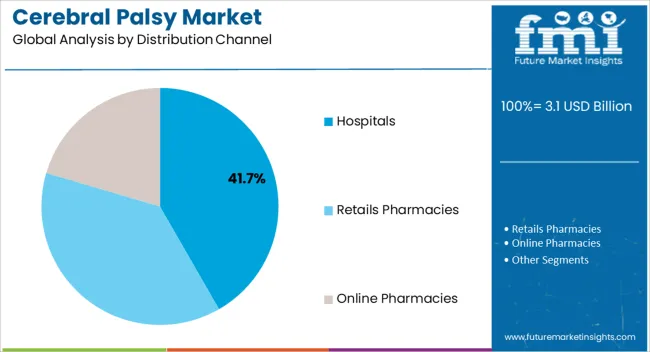
The hospitals distribution channel segment is projected to hold 41.7% of the market revenue in 2025, establishing it as the leading channel. Growth in this segment is being driven by the central role of hospitals in providing comprehensive care, including pharmacological treatment, therapy, and rehabilitation services for cerebral palsy patients. Hospitals offer access to specialized clinicians, structured treatment plans, and integrated care programs, which enhance patient outcomes.
The availability of advanced medications, including anticonvulsants and muscle relaxants, alongside physiotherapy and assistive devices, strengthens adoption through this channel. Partnerships between hospitals and pharmaceutical providers, coupled with streamlined procurement processes, further support the distribution of cerebral palsy therapies.
Rising awareness of early intervention and clinical best practices encourages caregivers to seek hospital-based treatments As hospitals continue to serve as primary centers for diagnosis, treatment, and long-term management, the segment is expected to maintain its leading position, driven by accessibility, trust in medical institutions, and comprehensive care offerings.
Cerebral Palsy is a neurological disorder caused by damage to developing brain of an infant during birth, before birth or immediately after birth. It affects the person’s ability to move as it affects body movement, muscle coordination, muscle tone (spasticity), motor skills including oral motor functioning.
Thus the person suffering from cerebral palsy shows the signs and symptoms of physical impairment, intellectual impairment, seizures, and vision or hearing impairment. Patient suffering from cerebral palsy has abnormal gait pattern as the affected limb becomes stiff leading to painful, awkward positions. The condition also affects balance, posture and coordination of a patient thus impacting daily routine activities of the patient suffering from CP.
However the signs and symptoms of cerebral palsy differ from person to person as the condition can affect one extremity or more than one extremity. Also some cases might land up into total paralysis and require aggressive treatment plan while other cases might show slight tremors that can be cured by physical therapy only. The severity of the condition depends upon the type of injury and the timing of the injury to the developing brain.
Cerebral Palsy market comprises of the drugs which cures symptoms caused by the cerebral palsy such as drugs for uncontrolled body movements, controlling seizures, spasticity, pain etc. Major companies in cerebral palsy market deals with anti-spastic medications
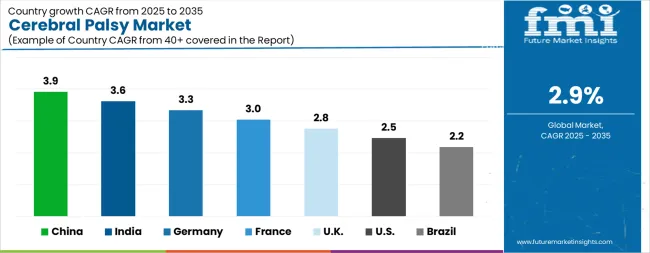
| Country | CAGR |
|---|---|
| China | 3.9% |
| India | 3.6% |
| Germany | 3.3% |
| France | 3.0% |
| UK | 2.8% |
| USA | 2.5% |
| Brazil | 2.2% |
The Cerebral Palsy Market is expected to register a CAGR of 2.9% during the forecast period, exhibiting varied country level momentum. China leads with the highest CAGR of 3.9%, followed by India at 3.6%. Developed markets such as Germany, France, and the UK continue to expand steadily, while the USA is likely to grow at consistent rates. Brazil posts the lowest CAGR at 2.2%, yet still underscores a broadly positive trajectory for the global Cerebral Palsy Market. In 2024, Germany held a dominant revenue in the Western Europe market and is expected to grow with a CAGR of 3.3%. The USA Cerebral Palsy Market is estimated to be valued at USD 1.1 billion in 2025 and is anticipated to reach a valuation of USD 1.4 billion by 2035. Sales are projected to rise at a CAGR of 2.5% over the forecast period between 2025 and 2035. While Japan and South Korea markets are estimated to be valued at USD 166.6 million and USD 92.6 million respectively in 2025.
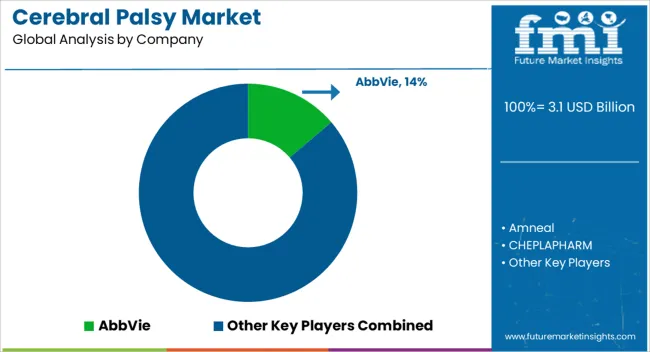
| Item | Value |
|---|---|
| Quantitative Units | USD 3.1 Billion |
| Drug Type | Anticonvulsants Drugs, Anticholinergic Drugs, Antidepressants Drugs, Anti-Spastic Drugs, Anti-Inflammatory Drugs, and Others |
| Type Of Cerebral Palsy | Spastic Cerebral Palsy, Dyskinetic Cerebral Palsy, Hypotonic Cerebral Palsy, Ataxic Cerebral Palsy, and Mixed Cerebral Palsy |
| Distribution Channel | Hospitals, Retails Pharmacies, and Online Pharmacies |
| Regions Covered | North America, Europe, Asia-Pacific, Latin America, Middle East & Africa |
| Country Covered | United States, Canada, Germany, France, United Kingdom, China, Japan, India, Brazil, South Africa |
| Key Companies Profiled | AbbVie, Amneal, CHEPLAPHARM, Dr.Reddy's, GSK, IPSEN, Merz Pharmaceuticals, Novartis, Roche, Teva, UCB, and VIATRIS |
The global cerebral palsy market is estimated to be valued at USD 3.1 billion in 2025.
The market size for the cerebral palsy market is projected to reach USD 4.1 billion by 2035.
The cerebral palsy market is expected to grow at a 2.9% CAGR between 2025 and 2035.
The key product types in cerebral palsy market are anticonvulsants drugs, anticholinergic drugs, antidepressants drugs, anti-spastic drugs, anti-inflammatory drugs and others.
In terms of type of cerebral palsy, spastic cerebral palsy segment to command 32.4% share in the cerebral palsy market in 2025.

Thank you!
You will receive an email from our Business Development Manager. Please be sure to check your SPAM/JUNK folder too.
Chat With
MaRIA